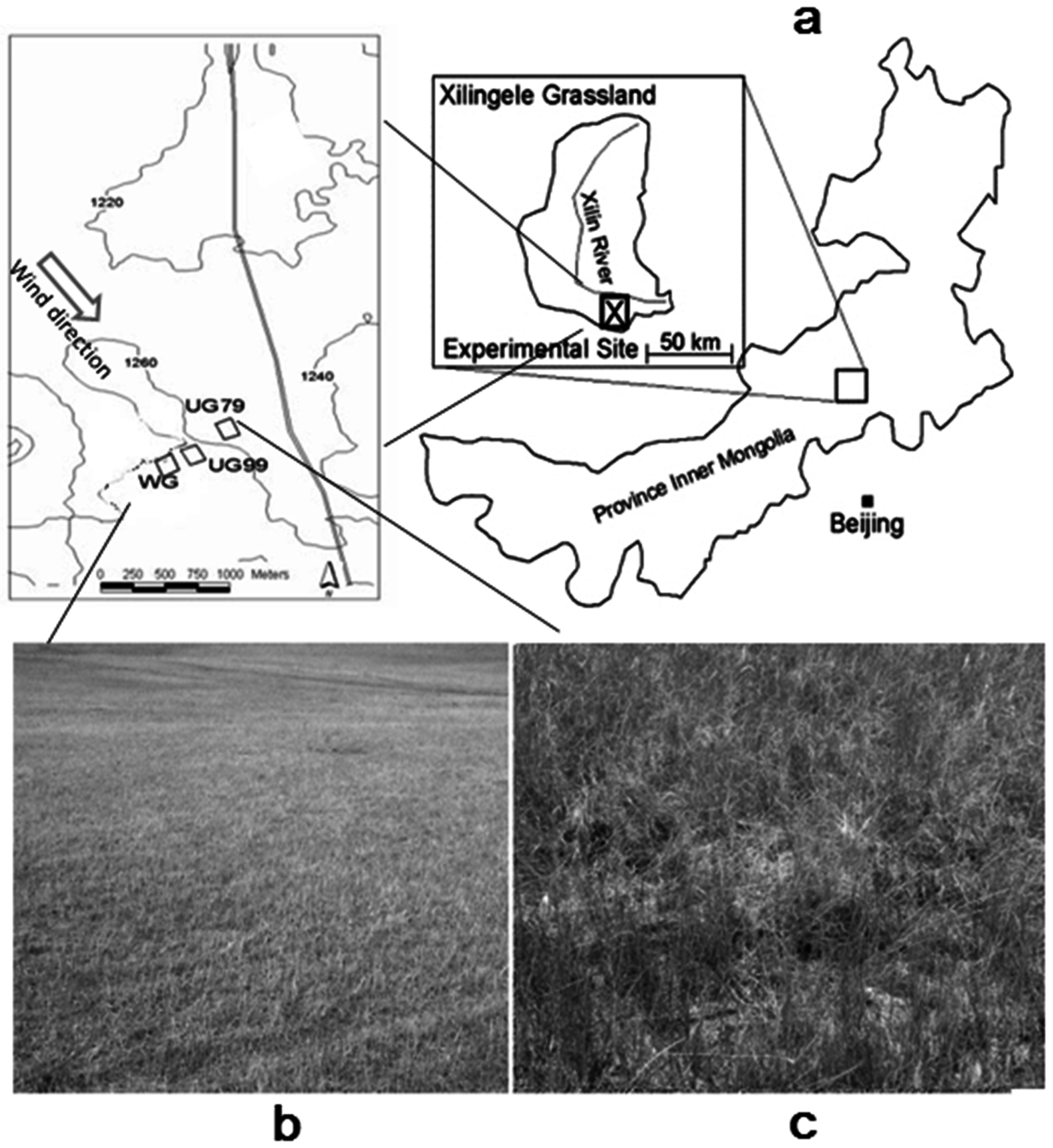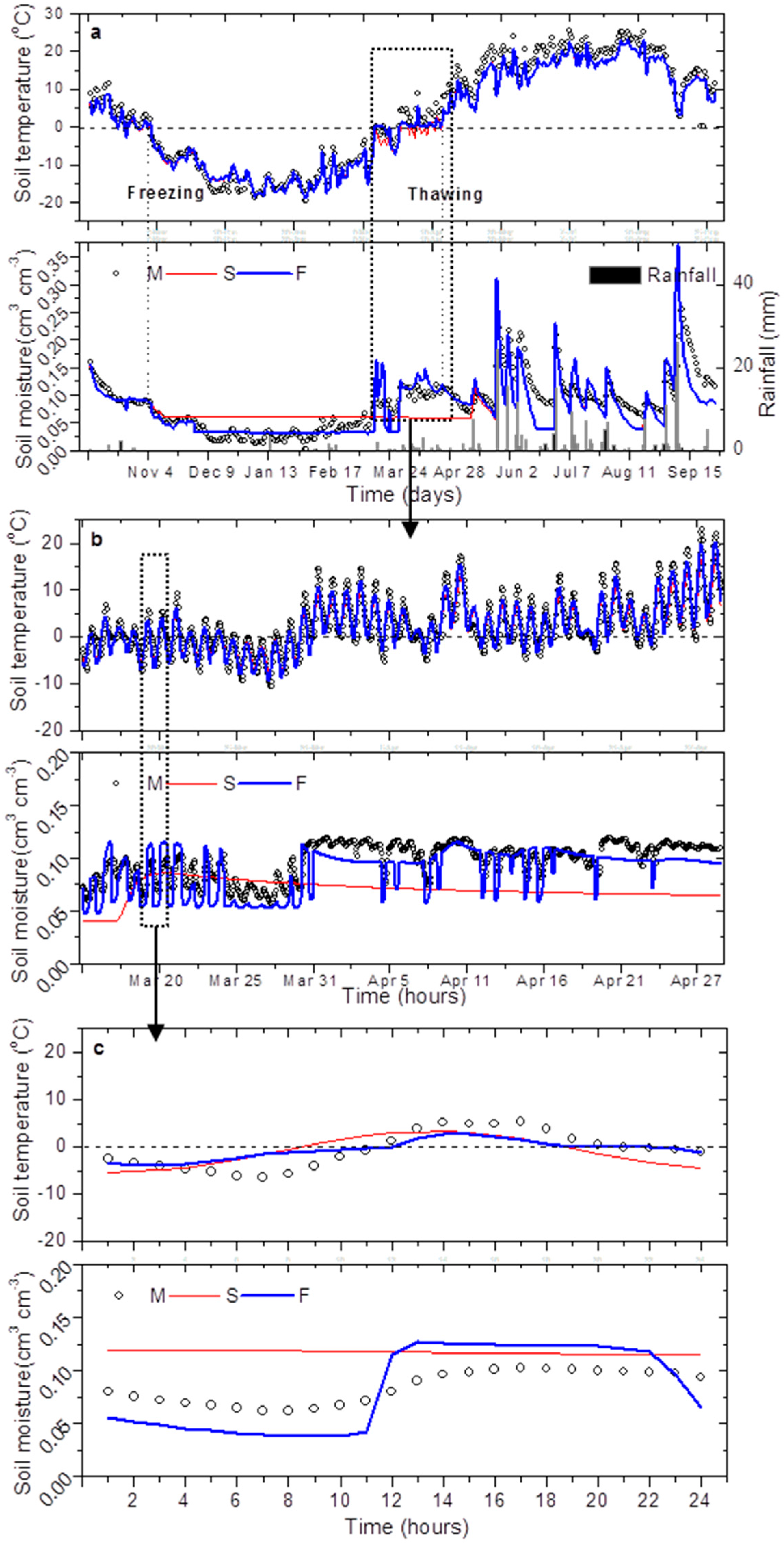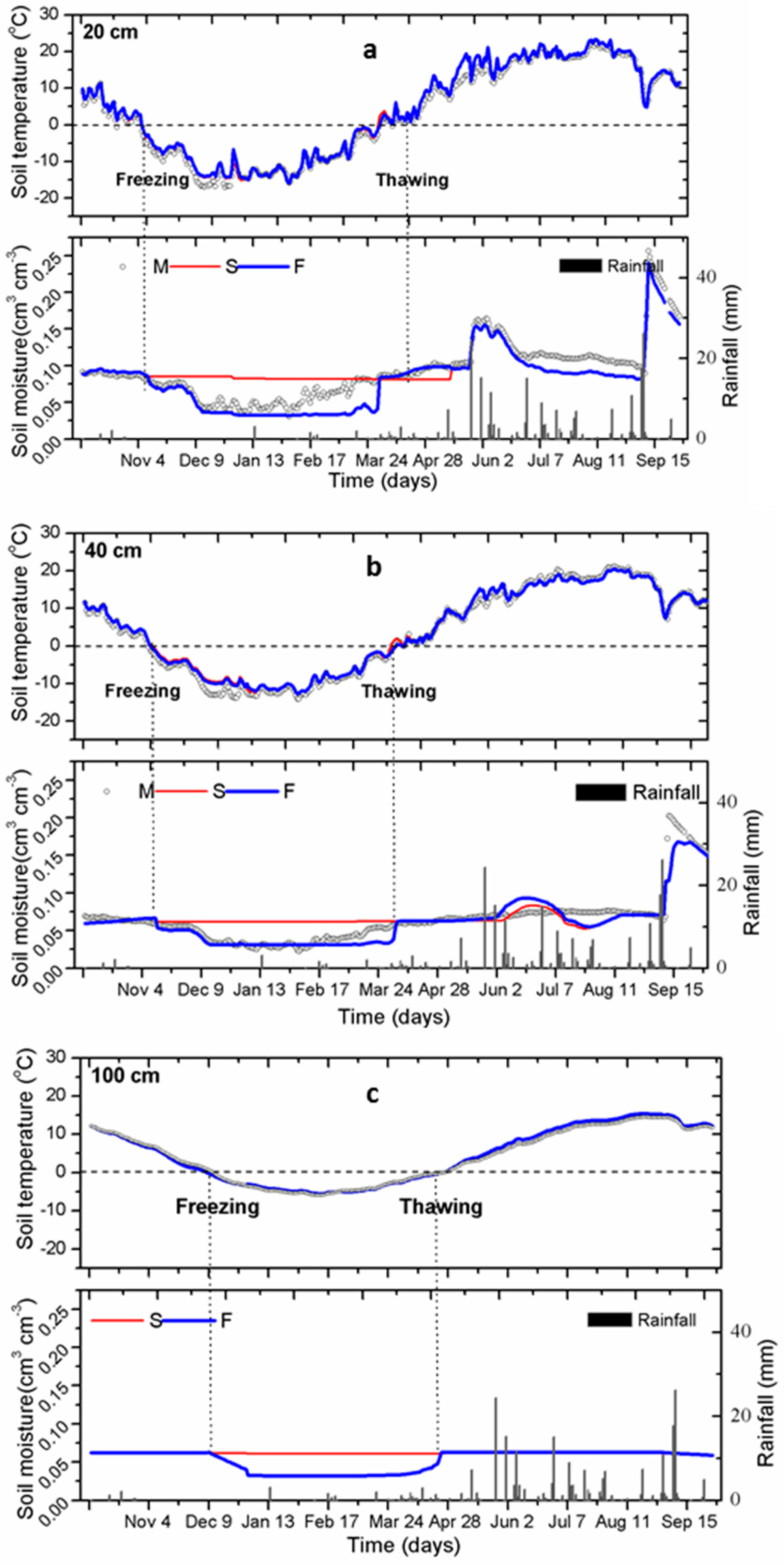Modeling of Coupled Water and Heat Transfer in Freezing and Thawing Soils, Inner Mongolia
Abstract
:1. Introduction
2. Materials and Methods
2.1. Study Area
2.2. Liquid and Ice Water Flow
2.3. Soil Heat Transport
2.4. Initial and Boundary Conditions
2.5. Water and Heat Flow Simulations
3. Results and Discussion
3.1. Grazing Effects on Soil Properties, Soil Water and Temperature Regimes
3.2. Simulated Soil Temperatures and Water Contents
3.3. Simulation of Runoff in Frozen Soil
3.4. Simulation of Grazing Effects on Soil Freezing and Thawing
4. Conclusions
Acknowledgments
Author Contributions
Conflicts of Interest
References
- Saito, H.; Šimůnek, J.; Mohanty, B.P. Numerical analysis of coupled water, vapor, and heat transport in the vadose zone. Vadose Zone J. 2006, 5, 784–800. [Google Scholar] [CrossRef]
- Zhao, Y.; Nishimura, T.; Hill, R.; Miyazaki, T. Determining hydraulic conductivity for air-filled porosity in an unsaturated frozen soil by the multistep outflow method. Vadose Zone J. 2013. [Google Scholar] [CrossRef]
- Lewkowicz, A.G.; Kokelj, S.V. Slope sediment yield in arid lowland continuous permafrost environments: Canadian Arctic Archipelago. Catena 2002, 46, 261–283. [Google Scholar] [CrossRef]
- Bayard, D.; Stahli, M.; Parriaux, A.; Fluhler, H. The influence of seasonally frozen soil on the snowmelt runoff at two Alpine sites in southern Switzerland. J. Hydrol. 2005, 309, 66–84. [Google Scholar] [CrossRef]
- Harlan, R.L. Analysis of coupled heat-fluid transport in partially frozen soil. Water Resour. Res. 1973, 9, 1314–1323. [Google Scholar] [CrossRef]
- Flerchinger, G.N.; Saxton, K.E. Simultaneous heat and water model of a freezing snow-residue-soil system I. Theory and development. Trans. ASAE 1989, 32, 565–571. [Google Scholar] [CrossRef]
- Miller, R.D. Freezing phenomena in soils. In Applications of Soil Physics; Hillel, D., Ed.; Academic Press: New York, NY, USA, 1980; pp. 254–299. [Google Scholar]
- Hansson, K.; Šimůnek, J.; Mizoguchi, M.; Lundin, L.-C.; van Genuchten, M.T. Water flow and heat transport in frozen soil: Numerical solution and freeze-thaw applications. Vadose Zone J. 2004, 3, 693–704. [Google Scholar] [CrossRef]
- Wang, L.; Koike, T.; Yang, K.; Jin, R.; Li, H. Frozen soil parameterization in a distributed biosphere hydrological model. Hydrol. Earth Syst. Sci. 2010, 4, 557–571. [Google Scholar] [CrossRef]
- Zhang, X.; Sun, S.; Xue, Y. Development and testing of a frozen soil parameterization for cold region studies. J. Hydrometeorol. 2007, 8, 690–701. [Google Scholar] [CrossRef]
- Seyfried, M.S.; Murdock, M.D. Use of air permeability to estimate infiltrability of frozen soil. J. Hydrol. 1997, 202, 95–107. [Google Scholar] [CrossRef]
- Zhao, Y.; Peth, S.; Horn, R. Modeling of coupled water and heat fluxes in both unfrozen and frozen soils. In Proceedings of the HYDRUS Workshop, Prague, Czech, 28 March 2008; Šimůnek, J., Kodešová, R., Eds.; Czech University of Life Sciences: Prague, Czech Republic, 2008; pp. 55–60. [Google Scholar]
- Koopmans, R.W.R.; Miller, R.D. Soil freezing and soil water characteristic curves. Soil Sci. Soc. Am. J. 1966, 30, 680–685. [Google Scholar] [CrossRef]
- Šimůnek, J.; van Genuchten, M.T.; Šejna, M. Recent developments and applications of the HYDRUS computer software packages. Vadose Zone J. 2016. [Google Scholar] [CrossRef]
- Luo, L.F.; Robock, A.; Vinnikov, K.Y.; Adam Schlosser, C.; Slater, A.G. Effects of frozen soil on soil temperature, spring infiltration, and runoff: Results from the PILPS 2(d) Experiment at Valdai, Russia. J. Hydrometeorol. 2003, 4, 334–351. [Google Scholar] [CrossRef]
- Wolf, B.; Kiese, R.; Chen, W.; Grote, R.; Zheng, X.; Butterbach-Bahl, K. Modeling N2O emissions from steppe in Inner Mongolia, China, with consideration of spring thaw and grazing intensity. Plant Soil 2012, 350, 297–310. [Google Scholar] [CrossRef]
- Jansson, P.-E.; Halldin, S. Soil Water and Heat Model: Technical Description; Swedish Coniferous Forest Project. Tech. Rep. 26; Swedish University of Agricultural Sciences: Uppsala, Sweden, 1980. [Google Scholar]
- Kurylyk, B.L.; Watanabe, K. The mathematical representation of freezing and thawing processes in variably-saturated, non-deformable soils. Adv. Water Res. 2013, 60, 160–177. [Google Scholar] [CrossRef]
- Krümmelbein, J.; Wang, Z.; Zhao, Y.; Peth, S.; Horn, R. Influence of various grazing intensities on soil stability, soil structure and water balance of grassland soils in Inner Mongolia, P. R. China. In Advances in Geoecology; Horn, R., Fleige, H., Peth, S., Peng, X., Eds.; Catena Verlag: Reiskirchen, Germany, 2006; Volume 38, pp. 93–101. [Google Scholar]
- Liu, Z.; Yu, X. Coupled thermo-hydro-mechanical model for porous materials under frost action: Theory and implementation. Acta Geotech. 2011, 6, 51–65. [Google Scholar] [CrossRef]
- Zhao, Y.; Peth, S.; Horn, R.; Krümmelbein, J.; Ketzer, B.; Gao, Y.; Doerner, J.; Bernhofer, C.; Peng, X. Modelling grazing effects on coupled water and heat fluxes in Inner Mongolia grassland. Soil Tillage Res. 2010, 109, 75–86. [Google Scholar] [CrossRef]
- Zhao, Y.; Peth, S.; Reszkowska, A.; Gan, L.; Krümmelbein, J.; Peng, X.; Horn, R. Response of soil moisture and temperature to grazing intensity in a Leymus chinensis steppe, Inner Mongolia. Plant Soil 2011, 340, 89–102. [Google Scholar] [CrossRef]
- Ketzer, B.; Liu, H.Z.; Bernhofer, C. Surface characteristics of grasslands in Inner Mongolia as detected by micrometeorological measurements. Int. J. Biometeorol. 2008, 52, 563–574. [Google Scholar] [CrossRef] [PubMed]
- Iwata, Y.; Hayashi, M.; Suzuki, S.; Hirota, T.; Hasegawa, S. Effects of snow cover on soil freezing, water movement, and snowmelt infiltration: A paired plot experiment. Water Resour. Res. 2010, 46, 1–11. [Google Scholar] [CrossRef]
- Liu, C.; Holst, J.; Brüggemann, N.; Butterbach-Bahl, K.; Yao, Z.; Jin, Y.; Han, S.; Han, X.; Krümmelbein, J.; Horn, R.; et al. Winter-grazing reduces methane uptake by soils of a typical semi-arid steppe in Inner Mongolia. China Atmos. Environ. 2007, 41, 5948–5958. [Google Scholar] [CrossRef]
- United States Department of Agriculture. Keys to Soil Taxonomy, 10th ed.Natural Resources Conservation Service, United States Department of Agriculture: Washington, DC, USA, 2006.
- Steffens, M.; Kölbl, A.; Totsche, K.U.; Kögel-Knabner, I. Grazing effects on soil chemical and physical properties in a semiarid steppe of Inner Mongolia (PR China). Geoderma 2008, 143, 63–72. [Google Scholar] [CrossRef]
- Hoffmann, C.; Funk, R.; Li, Y.; Sommer, M. Effect of grazing on wind driven carbon and nitrogen ratios in the grasslands of Inner Mongolia. Catena 2008, 75, 182–190. [Google Scholar] [CrossRef]
- Van Genuchten, M.T. A closed-form equation for predicting the hydraulic conductivity of unsaturated soils. Soil Sci. Soc. Am. J. 1980, 44, 892–898. [Google Scholar] [CrossRef]
- Lundin, L.-C. Hydraulic properties in an operational model of frozen soil. J. Hydrol. 1990, 118, 289–310. [Google Scholar] [CrossRef]
- Noborio, K.; McInnes, K.J.; Heilman, J.L. Two-dimensional model for water, heat and solute transport in furrow-irrigated soil: I. Theory. Soil Sci. Soc. Am. J. 1996, 60, 1001–1009. [Google Scholar] [CrossRef]
- Nimmo, J.R.; Miller, E.E. The temperature dependence of isothermal moisture vs. potential characteristics of soils. Soil Sci. Soc. Am. J. 1986, 50, 1105–1113. [Google Scholar] [CrossRef]
- De Vries, D.A. The thermal properties of soils. In Physics of Plant Environment; Van Wijk, R.W., Ed.; North-Holland Publishing Company: Amsterdam, The Netherlands, 1963; pp. 210–235. [Google Scholar]
- Chung, S.; Horton, R. Soil heat and water flow with a partial surface mulch. Water Resour. Res. 1987, 23, 2175–2186. [Google Scholar] [CrossRef]
- Dall’Amico, M.; Endrizzi, S.; Gruber, S.; Rigon, R. A robust and energy-conserving model of freezing variably-saturated soil. Cryosphere 2011, 5, 469–484. [Google Scholar] [CrossRef]
- Allen, R.G.; Pereira, L.S.; Raes, D.; Smith, M. Crop Evapotranspiration. Guidelines for Computing Crop Water Requirements; Irrigation and Drainage Paper No. 56; FAO: Rome, Italy, 1998; p. 300. [Google Scholar]
- Feddes, R.A.; Kowalik, P.J.; Zaradny, H. Simulation of Field Water Use and Crop Yield; John Wiley and Sons: New York, NY, USA, 1978. [Google Scholar]
- Jarvis, N.J. The MACRO Model (Version 3.1), Technical Description and Sample Simulations; Reports and Dissertations 19; Deptment of Soil Sciences, Swedish University of Agricultural Sciences: Uppsala, Sweden, 1994. [Google Scholar]
- Zhao, Y.; Huang, M.B.; Horton, R.; Liu, F.; Peth, S.; Horn, R. Influence of winter grazing on water and heat flow in seasonally frozen soil of Inner Mongolia. Vadose Zone J. 2013, 12. [Google Scholar] [CrossRef]
- Li, H.; Yi, J.; Zhang, J.; Zhao, Y.; Si, B.; Hill, R.; Cui, L.; Liu, X. Modeling of soil water and salt dynamics with shallow water table and its effects on root water uptake in Heihe Arid Wetland, Gansu, China. Water 2015, 7, 2382–2401. [Google Scholar] [CrossRef]
- Yi, J.; Zhao, Y.; Shao, M.A.; Zhang, J.G.; Cui, L.L.; Si, B.C. Soil freezing and thawing processes affected by the different landscapes in the middle reaches of Heihe River Basin, Gansu, China. J. Hydrol. 2014, 519, 1328–1338. [Google Scholar] [CrossRef]
- He, H.L.; Dyck, M. Application of multiphase dielectric mixing models for understanding the effective dielectric permittivity of frozen soils. Vadose Zone J. 2013, 12. [Google Scholar] [CrossRef]
- Zhang, Y.; Treberg, M.; Carey, S.K. Evaluation of the heat pulse probe method for determining frozen soil moisture content. Water Resour. Res. 2011, 47, 143–158. [Google Scholar] [CrossRef]
- Tian, Z.C.; Heitman, J.; Horton, R.; Ren, T.S. Determining soil ice contents during freezing and thawing with thermo-time domain reflectometry. Vadose Zone J. 2015, 14. [Google Scholar] [CrossRef]
- Smirnova, T.G.; Brown, J.M.; Benjamin, S.G. Performance of different soil model configurations in simulating ground surface temperature and surface fluxes. Mon. Weather Rev. 1997, 125, 1870–1884. [Google Scholar] [CrossRef]
- Mitchell, J.F.B.; Warrilow, D.A. Summer dryness in northern mid-latitudes due to increased CO2. Nature 1987, 341, 132–134. [Google Scholar] [CrossRef]
- Pitman, A.J.; Slater, A.G.; Desborough, C.E. Uncertainty in the simulation of runoff due to the parameterization of frozen soil moisture using the Global Soil Wetness Project methodology. J. Geophys. Res. 1999, 104, 16879–16888. [Google Scholar] [CrossRef]
- Cherkauer, K.A.; Lettenmaier, D.P. Hydrologic effects of frozen soils in the upper Mississippi River basin. J. Geophys. Res. 1999, 104, 19599–19610. [Google Scholar] [CrossRef]
- Hillel, D. Environmental Soil Physics; Academic Press: London, UK, 1998; p. 771. [Google Scholar]






| Treatment | Soil Depth (cm) | Sand (%) | Silt (%) | Clay (%) | Bulk Density (g·cm−3) | Soil Organic Carbon (g·kg−1) | θr (cm3·cm−3) | θs (cm3·cm−3) | α (cm−1) | n (-) | Ks (cm·day−1) |
|---|---|---|---|---|---|---|---|---|---|---|---|
| UG79 | 4–8 | 62.0 | 22.2 | 15.8 | 1.14 | 22.0 | 0.075 | 0.572 | 0.026 | 1.766 | 165.0 |
| 18–22 | 73.0 | 14.6 | 12.4 | 1.39 | 16.5 | 0.086 | 0.472 | 0.019 | 2.199 | 133.3 | |
| 30–34 | 78.1 | 11.0 | 10.9 | 1.44 | 10.1 | 0.079 | 0.453 | 0.015 | 2.549 | 113.7 | |
| 40–44 | 78.7 | 11.6 | 9.7 | 1.43 | 8.2 | 0.071 | 0.452 | 0.016 | 2.120 | 71.9 | |
| WG | 4–8 | 53.7 | 27.2 | 19.1 | 1.18 | 22.2 | 0.075 | 0.57 | 0.021 | 1.636 | 54.7 |
| 18–22 | 58.4 | 23.9 | 17.7 | 1.29 | 13.2 | 0.050 | 0.526 | 0.023 | 1.616 | 69.8 | |
| 30–34 | 59.3 | 24.3 | 16.5 | 1.27 | 11.4 | 0.072 | 0.529 | 0.012 | 1.791 | 72.7 | |
| 40–44 | 60.4 | 22.8 | 16.9 | 1.34 | 11.6 | 0.079 | 0.517 | 0.014 | 1.742 | 61.3 |
| Treatment | Depth (cm) | Month (October 2005–September 2006) | Average in Winter | Period of Ground Freezing (Day) | |||||||||||
|---|---|---|---|---|---|---|---|---|---|---|---|---|---|---|---|
| 10 | 11 | 12 | 1 | 2 | 3 | 4 | 5 | 6 | 7 | 8 | 9 | ||||
| UG79 | 2 | 5.1 | −5.3 | −12.9 | −13.6 | −11.5 | −4.3 | 4.2 | 15.5 | 18.5 | 20.8 | 22.2 | 11.0 | −7.2 | 144 |
| 8 | 5.7 | −4.3 | −11.8 | −12.9 | −11.2 | −4.6 | 3.5 | 13.8 | 17.6 | 20.2 | 21.3 | 11.6 | −6.9 | 146 | |
| 20 | 6.7 | −2.5 | −9.8 | −11.5 | −10.3 | −4.9 | 2.4 | 11.2 | 16.1 | 19.0 | 20.1 | 12.4 | −6.1 | 145 | |
| 40 | 8.0 | −0.1 | −6.9 | −9.4 | −8.9 | −5.0 | 0.9 | 8.4 | 13.9 | 17.1 | 18.5 | 13.3 | −4.9 | 148 | |
| 100 | 10.2 | 4.6 | −1.0 | −4.2 | −5.2 | −4.0 | −0.9 | 4.3 | 9.4 | 13.1 | 14.9 | 13.7 | −1.8 | 136 | |
| WG | 2 | 4.9 | −5.5 | −14.8 | −15.5 | −12.6 | −4.5 | 4.7 | 15.9 | 19.0 | 21.1 | 22.6 | 12.2 | −8.0 | 143 |
| 8 | 4.9 | −5.2 | −14.3 | −15.3 | −12.8 | −5.2 | 3.8 | 14.0 | 17.8 | 20.4 | 21.6 | 12.0 | −8.2 | 146 | |
| 20 | 6.8 | −2.5 | −11.1 | −13.2 | −11.4 | −5.3 | 2.5 | 10.9 | 15.9 | 19.0 | 20.2 | 12.8 | −6.8 | 145 | |
| 40 | 7.2 | −1.6 | −9.6 | −12.1 | −10.7 | −5.3 | 2.1 | 9.9 | 15 | 18.3 | 19.6 | 12.9 | −6.2 | 144 | |
| 100 | 9.8 | 4.7 | −1.0 | −4.7 | −5.5 | −3.8 | −0.8 | 3.4 | 8.1 | 12.0 | 13.9 | 12.6 | −1.9 | 136 | |
© 2016 by the authors; licensee MDPI, Basel, Switzerland. This article is an open access article distributed under the terms and conditions of the Creative Commons Attribution (CC-BY) license (http://creativecommons.org/licenses/by/4.0/).
Share and Cite
Zhao, Y.; Si, B.; He, H.; Xu, J.; Peth, S.; Horn, R. Modeling of Coupled Water and Heat Transfer in Freezing and Thawing Soils, Inner Mongolia. Water 2016, 8, 424. https://doi.org/10.3390/w8100424
Zhao Y, Si B, He H, Xu J, Peth S, Horn R. Modeling of Coupled Water and Heat Transfer in Freezing and Thawing Soils, Inner Mongolia. Water. 2016; 8(10):424. https://doi.org/10.3390/w8100424
Chicago/Turabian StyleZhao, Ying, Bingcheng Si, Hailong He, Jinghui Xu, Stephan Peth, and Rainer Horn. 2016. "Modeling of Coupled Water and Heat Transfer in Freezing and Thawing Soils, Inner Mongolia" Water 8, no. 10: 424. https://doi.org/10.3390/w8100424
APA StyleZhao, Y., Si, B., He, H., Xu, J., Peth, S., & Horn, R. (2016). Modeling of Coupled Water and Heat Transfer in Freezing and Thawing Soils, Inner Mongolia. Water, 8(10), 424. https://doi.org/10.3390/w8100424








